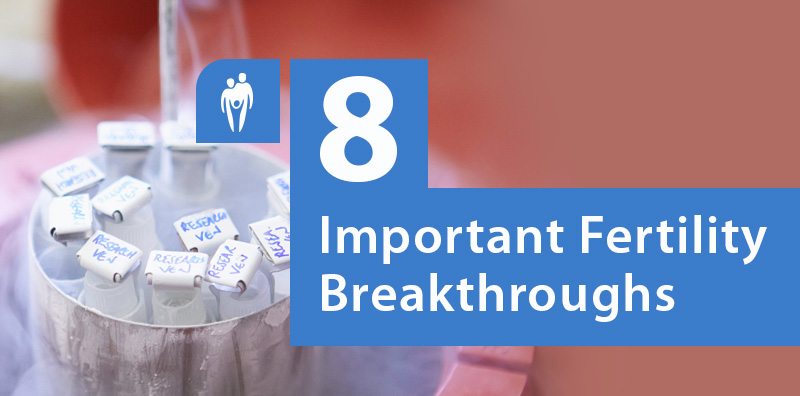
21:17 20th May 2017 | Fertility Breakthrough
Babies Fertility Treatment Frozen Sperm Frozen Eggs Frozen Embryos IVF Process Genetic Abnormalities Chromosomal Abnormalities Embryo Transfer
The world has seen so many fertility breakthroughs in the last couple of decades. To think, babies have been conceived after using sperm that had been frozen for over 20 years; IVF treatments have resulted in the birth of over 5 million babies; ovarian tissue freezing can be performed; and even uterine transplantations. This article will cover eight major fertility breakthroughs you want to know about.
Frozen Sperm, Eggs and Embryos
Babies have been conceived and successfully born from frozen sperm, frozen embryos and frozen eggs. This once cutting-edge technology is a standard option today when it comes to fertility treatment and conception. Why it’s important: men can freeze sperm and women can preserve healthy eggs before undergoing chemotherapy; couples who go through the IVF process can store embryos for future use; eggs, sperm and embryos can be donated to assist couples who cannot conceive on their own.
First birth from a frozen egg: 1986
First birth from frozen embryo: 1984
Oldest frozen sperm resulting in successful birth of fraternal/non identical twins): Approximately 40 Years (In 1971, a man aged between 52 and 53 had his sperm frozen. It was used at the Alta Bates IVF Program between 2009 and 2011.)
Optimising IVF
IVF is the process of fertilising the female egg, outside of the body, with a male sperm, to create an embryo, which can then be transferred to the female uterus. Louise Joy Brown was the first IVF baby, born in 1987. Today, more than 5 million IVF babies have been born. IVF success rates are also being improved by PGD (preimplantation genetic diagnosis), PGS (preimplantation genetic screening) and cell division monitoring.
Genetic and Chromosomal Screening for IVF
When requested, as an additional procedure, IVF specialists can now analyse 5-day-old embryos to search for genetic or chromosomal abnormalities. A more extensive analysis can be done compared to earlier tests when younger embryos were tested. This technique is considered to increase successful pregnancy rates as well as significantly reduce miscarriage rates because healthier embryos can be identified before implantation.
Time-lapse Photos of IVF
With the use of time lapse-imaging, it’s possible to see when embryos turn into blastocysts. For 5 to 6 days the IVF embryos are monitored so that the ones which seem to develop the most normally can be chosen for implantation.
Single Embryo Transfer
In the past, two or more IVF embryos were often transferred to the uterus (after only one or two days) to increase the chance of pregnancy. These days, a single embryo, that has had a few more days to develop, is the more preferred choice. It is believed that the chance of implantation is increased due to the extra growth time and that the risk of premature birth is also reduced. Additional embryos can always be frozen for later use.
ICSI
Intracytoplasmic Sperm Injection (ICSI) is a technique developed in the early 1990s where a single sperm is injected directly into an egg for fertilisation. It is often used to help with male infertility challenges with a 50% to 80% fertilisation success rate. However, in many cases, male infertility is not a requirement.
Ovarian Tissue Freezing
The future fertility of women undergoing chemotherapy and/or radiation can be preserved with the use of ovarian tissue freezing, a recently developed technique. Ovarian tissue is removed, frozen and reimplanted when required. An artificial human ovary has also been developed allowing women suffering from cancer to store their eggs in a safe place before they receive egg-compromising treatments.
A Successful Uterine Transplant
A successful uterine transplant (from a 61-year-old postmenopausal mother of two) allowed a woman to fall pregnant and give birth in September 2014. The patient (36) had functioning ovaries, but was born without a uterus. This new type of transplant has be attempted before to help women without a uterus or women with a non-functioning uterus, however, this was the first time a live birth was recorded
How can we help you with infertility challenges?
Get in touch to make an appointment with a specialist at Bridge Clinic.
Eamil enquiries@thebridgeclinic.com | Call 01 631 0092 | Book Your Appointment Today
Sources: Medscape: 8 Major Fertility Breakthroughs by Bret S. Stetka (MD; WebMD Editors) on March 12, 2015
Search by condition, treatment or keyword and conveniently browse our informative articles
Book an appointment online or search for a clinic close to you.
Book an Appointment